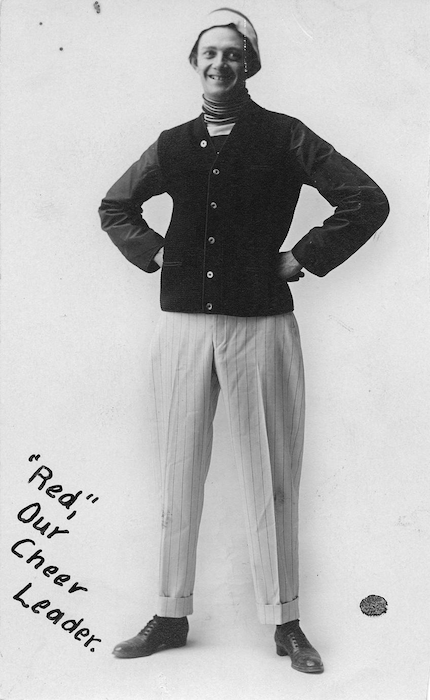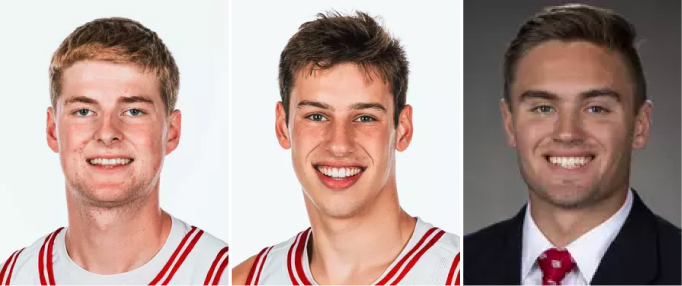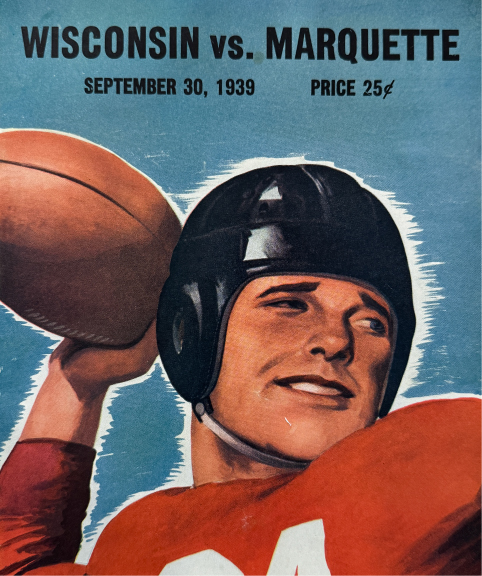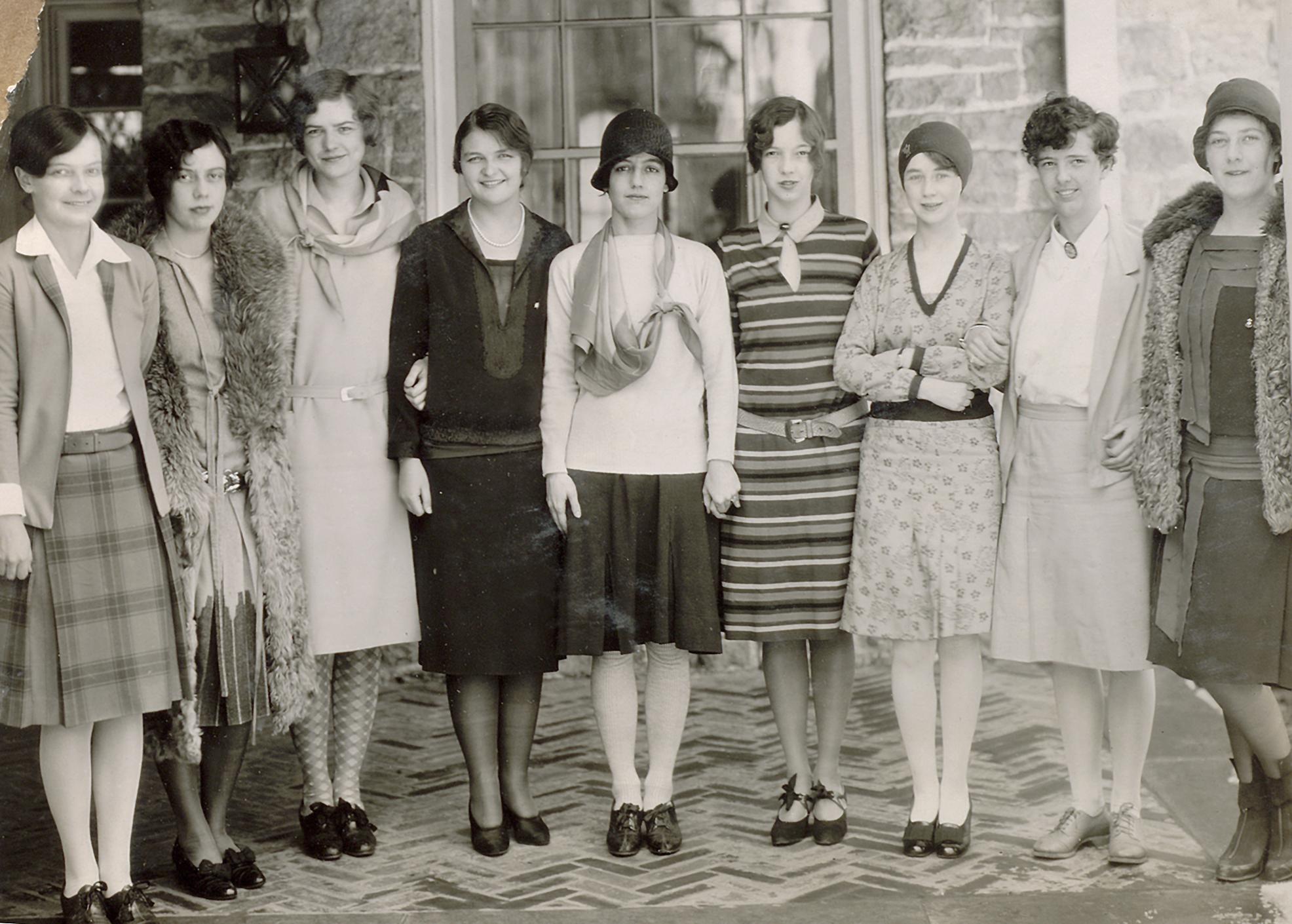Whether it’s the die-hard Badger fanbase, legendary players and coaches, iconic stadiums, or the chants and cheers that ring throughout dozens of arenas during any sporting event, it’s hard to miss the culture surrounding athletics at UW-Madison. These elements are just some of the most prominent characteristics of sports at UW, but the long history of athletics on campus is also filled with countless stories that may not yet have been heard. Students in a brand-new Communication Arts course taught this spring, History of UW Sports and Media, worked in groups to conduct research and shed light on some of these stories that are under or unexplored throughout the history of UW Athletics. Here are some of their most intriguing discoveries:
___________________________________________________________________________________________________________
The Overlooked Early History of Cheerleading at UW-Madison:

Group members Charlotte Bental, Braden Caretta, Ashley Holland, Brooke Sholem, and Caleb Smith wanted to see how cheerleading has developed over the years at UW-Madison. The group recognized how impactful cheerleaders and chants are at every sporting event on campus, even though not much is publicly known or said about these historical traditions.
Many sources state the UW cheerleading team was established in the 1950s, coinciding with the brief period between 1952 and 1954 when women were allowed to join the team. Women were again barred from the team in the spring of 1954, but coed cheerleading was reinstated in the fall of 1956 and has grown as a UW sport since.
As the group dug through achieves on campus, however, they uncovered lots of evidence of male-led cheerleading teams dating back to the early 1900s. This research process helped the group discover one of the first UW–Madison cheerleaders from 1910, Reed Lynne “Red” Parker. Articles in The Daily Cardinal from this period refer to “Red” as a famous UW cheerleader who was super outgoing. But now, “Red” does not appear in a web search.
By looking through archives, this group helped uncover a 50+ year history of cheerleading at UW that is largely untold. This history is certain to have snowballed into the lively cheer traditions that are enjoyed at sporting events today.
The Walk-On Athlete Culture in Basketball and Football:

The next group, made up of members Alli Lenling, Taylor Riemer, Madison Szumylo, Rachel Van Hefty, and Tyler Yablon focused their research on how walk-on players, who are often overlooked in media and institutional representation, have shaped team dynamics and culture of football and basketball at the University of Wisconsin.
The group interviewed current UW basketball players, Steven Crowl and Jack Janicki. Along with these two, the group interviewed two former UW football players, Collin Larsh and Ben Strickland. Each interview began to shed light on the strength of the walk-on culture at UW. For example, Janicki turned down 14 scholarship offers and chose to walk on to the Wisconsin basketball team because of the program’s reputation.
In their interview with Crowl, the group learned that some of the most dedicated people on the team were the walk-on players. Crowl said that the walk-on athletes became lifelong friends, and he noticed these were the players who always gave full effort during every lift, practice, and scrimmage.
Many of the students in this group weren’t aware of what a walk-on player was at the start of the semester. This inspired them to pursue this topic and place some of UW–Madison’s walk-on football and basketball players in the spotlight.
Decades of Student Ticket Sale Controversies:
Interested in how season football tickets and purchasing policies for athletic events have changed throughout the years, group members Jack Chione, Kamyia Denson, Georgia Lerman, and Luka Simpson discovered how recent ticket purchasing controversies have mirrored similar situations dating back to the 1950s and 1970s.

Today, season ticket packages often sell out before every student with desire can get their hands on them. To meet a similar ticket demand in the 50s, the University worked to expand arenas and offer more seats for each game. A new student ID scanning system to purchase tickets was introduced in the 70s, but as demand continued to rise, students found loopholes in the system and began altering their IDs to qualify for more tickets, further draining the supply for other students.
Along with a long history of ticket controversies, the group also found numerous artifacts in the archives, such as physical tickets admitting a student into a football game for as little as 40 cents. These artifacts helped paint a more detailed picture of this small, yet important detail of attending a sporting event at UW–Madison.
The Lost UW Rivalries:

It is difficult to imagine what it would be like to lose the intense sports rivalry between the UW–Madison and a school like the University of Minnesota. Massive rivalries like these have dissolved in the past, however, particularly with the dismantling of football teams at Marquette University and the University of Chicago.
Group members Evan Engel, Jack Ericson, Joseph Herrmann, Matthew Lodarek, and Spencer Schick focused their research on these historic rivalries that no longer exist. By looking through various programs for football games, the group discovered many pep rally-like events hosted to coincide with the games, demonstrating the strong desire in the community to witness these showdowns.
UChicago was one of the original schools in the Big Ten Conference. They were also one of the earliest rivalries for UW, starting in the 1890s and ending in 1939 when the school decided to focus on academics rather than athletics.
The group also learned about the historic rivalry between UW–Madison and Marquette University. Most of the group members hadn’t known that Marquette formerly had a football team. When the Marquette team was dissolved, UW–Madison had already scheduled four future games with them, which shows the dedication our university had for the UW vs. Marquette rivalry.
Let’s Hear It for Women’s Hockey

One of the most successful sports teams on campus is the women’s hockey team, which has won eight NCAA national championships since 2006. Despite this, the team doesn’t generate profit and doesn’t receive much funding from the University. Group members Max Klesmit, Gavin Luebke, Grant Matheny, Palmer Papson, and Levi Schlimgen centered their project on the history of the women’s hockey team to uncover their success and their struggles.
The official women’s hockey team was formed in 1999 but was pre-dated by multiple women’s hockey clubs. The group discovered numerous photographs capturing players from teams as far back as the 1920s.
The group also found that before the LaBahn Arean stadium was built, which the women’s hockey team now considers home, the players had to drive to Verona, Wisconsin every day for practice. The students interviewed a former UW women’s hockey player who talked about the importance of the team culture they’ve built and that dedication to the sport, rather than revenue, propels them to their success. Regardless of how much the team is recognized, they continue to show up and fight to be one of the best women’s hockey teams in the nation.
___________________________________________________________________________________________________________
Communication Arts 313: History of Sports and Media is led by Professor Jason Kido Lopez. This class was born out of past work Kido Lopez has done with BIOS (Badger Inquiry on Sport) at UW–Madison, which works to connect academics and athletics and campus.
When discussing this research project, Kido Lopez highlighted its importance because it allows students to engage with archives and explore untold histories. As the students formed their arguments about these under-explored topics, they dug deeper into historical archives and library resources, conducted numerous interviews with coaches and players, and collaborated to bring these new stories from UW athletics to light.